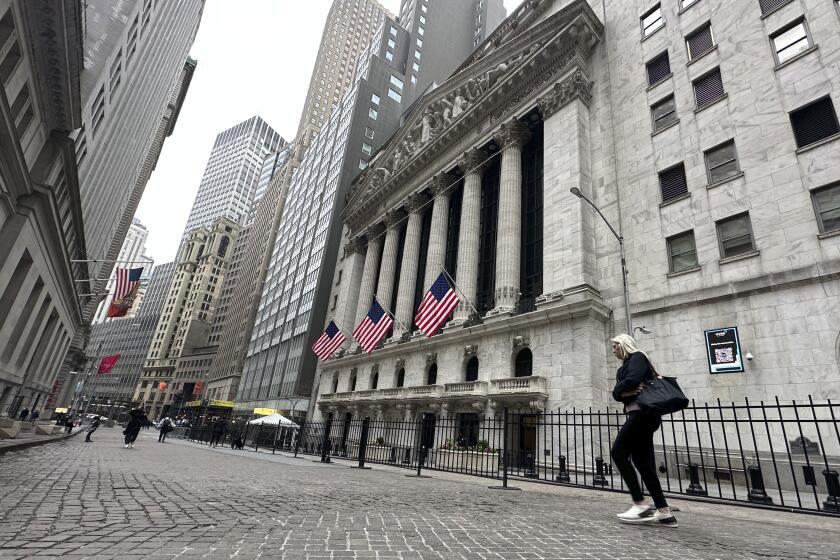Shopping Comeback Boosts Holiday Sales
After an uncertain start, shoppers finished out the holiday season on a strong note, all but ensuring that most retailers will log respectable sales gains.
Sales at established stores in the week ended Dec. 27 were up a solid 5.5% from last year, according to a closely watched tally of 79 retailers that was released Tuesday.
The week “made the season” for retailers, said Michael P. Niemira, chief economist and research director for the International Council of Shopping Centers, which compiled the so-called same-store sales results in conjunction with Wall Street investment firm UBS Securities. Same-store results are an important barometer of a retailer’s health because they are from stores open at least a year.
Across the country, the season got off to a fairly good start in November, partly because retailers made a strategic decision to lower prices early to lure customers. Then, in the first two weeks of December, major storms on the East Coast kept people at home. In the third week, sales bounced back and continued to gather steam through Christmas.
Niemira has been predicting for weeks that same-store sales would rise 4% for the entire November-December period, and he didn’t change his mind Tuesday. In any event, dazzling numbers won’t be needed to outshine 2002: Last year, same-store sales increased just 0.5% for November and December combined, the weakest gain in three decades.
This year, “it looks like this season came down to the wire,” said Ellen Tolley, a spokeswoman for the National Retail Federation, a leading industry trade group. “Most retailers were very pleased with the end results.”
She said 50 retail executives surveyed by the federation described themselves as feeling considerably cheerier this month about sales, store traffic and low inventory levels.
According to Visa USA, retail spending on Visa cards increased 10.3% to $43.2 billion in the four weeks leading up to Dec. 28, with Californians among those most readily wielding credit and debit cards. In an average month, Visa card retail sales are about $28 billion.
And retailing pollster ShopperTrak said there was a 24.6% increase in general merchandise sales last week as procrastinators, bargain hunters and consumers bearing gift cards converged on stores. (The huge upswing in the estimate was partly because the number is not adjusted to smooth out seasonal factors, including an extra shopping day between Thanksgiving and Christmas this year.)
Wall Street seemed to cheer the latest retailing news. On Tuesday, the Morgan Stanley index of 38 leading retailers rose 0.40%, putting it up 2.4% since Dec. 24.
Economists closely monitor shopper-survey results because consumer spending constitutes about two-thirds of the U.S. economy. The numbers released Tuesday indicate that “we’re continuing to see a nice, steady recovery, nothing overheated but nothing incredibly weak either,” said Alec Levenson, a labor economist at the USC Marshal School of Business.
The gain in the week ended Dec. 27 wasn’t enoughto prompt Niemira and other industry gurus to re-tally their predictions for the season. The retail federation has held fast to its forecast that overall sales will rise 5.7%.
“This was never going to be a spectacular holiday season,” Tolley said. “It was supposed to be a return to normal, and that’s what we found.”
Not all industry watchers were pleased Tuesday.
“We feel that many of these optimistic numbers may turn out to have been a little too optimistic,” said Kurt Barnard, president of Barnard’s Retail Trend Report, who was troubled by the fact that many retailers needed to slash prices to make sales. “Consumers began to buy once they realized they could get a bargain.”
Barnard also was bothered by an unexpected drop in consumer confidence reported by the Conference Board on Tuesday. The business research group said its index slipped to 91.3 from November’s year-plus high of 92.5. “The reason for that is concerns about jobs,” he said. “We are still dealing with an extremely cautious public, except in the case of very upscale stores.”
Higher-end retailers, including Nordstrom and Neiman Marcus, have been among this season’s strongest performers. And industry experts say that is partly due to the reemergence of “the wealth effect,” which occurs when the economy improves and the stock market surges, making consumers feel they have more money to spend.
As Levenson sees it, the consumer confidence index revealed more about how Americans are feeling about the news of the day, rather than how much they are willing to spend. “Basically, you want to watch what people do, not what they say,” he said.
There’s no shortage of evidence that consumers still want bargains. Indeed, the NRF survey also found that retailers are feeling pressured to lower prices.
Unplanned discounting erodes merchants’ profits, but many industry experts predict that will be less of a problem for retailers this year because inventories are so low.
This means there is less merchandise that retailers will feel they have to drastically mark down to get it out of stores and make way for spring goods, which already are arriving in some stores.
On the other hand, lean inventories could mean retailers will have trouble capitalizing on any desire by consumers to prolong their shopping binge, Niemira said.
“If in fact inventories were really drained because of the surge at the end, we may see sales fall off pretty quickly in this week and early January,” he said. “You have all this gift card money out there but nothing to spend it on.”






